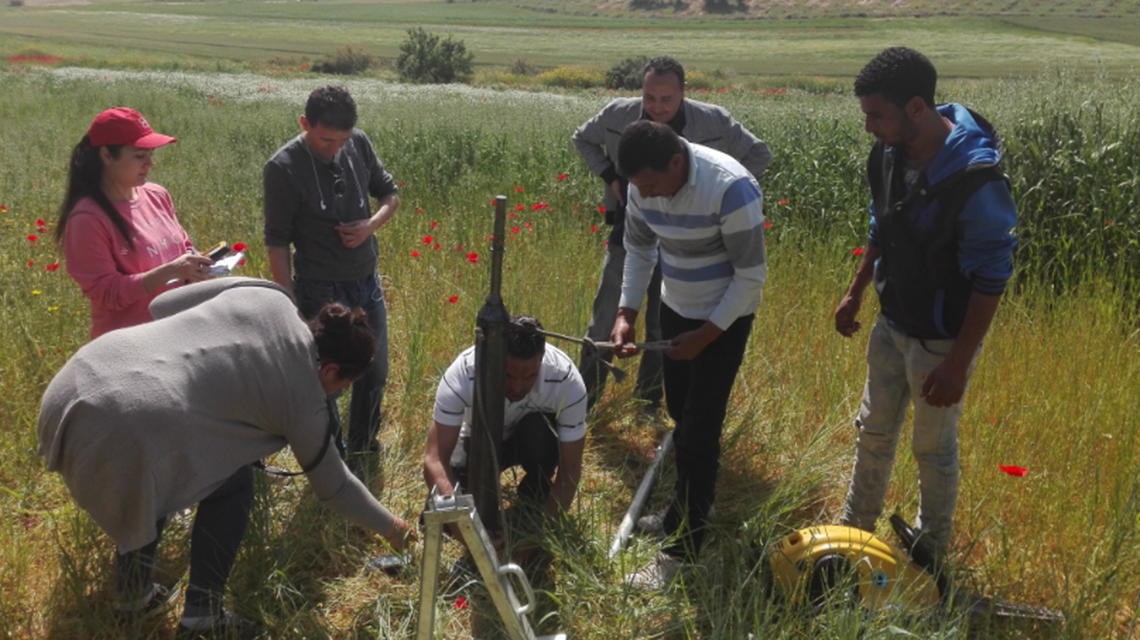Soil and water, two ingredients that support Tunisia’s rich agriculture, have been under threat in recent years due to climate change and increasing soil erosion. Some of the country’s most fertile soil is removed, degrading land and clogging lakes. Reversing this trend requires protecting the environment, conserving the soil, and applying isotopic techniques, which are helping experts to evaluate the effectiveness of traditional soil conservation methods and thereby optimize their practices.
Measuring soil erosion
A project with the support from the IAEA, in partnership with the Food and Agriculture Organization of the United Nations (FAO) and in cooperation with the National Center for Nuclear Sciences and Technologies (CNSTN), has been using fallout radionuclide caesium-137 (Cs-137) as a tracer to measure the rate of soil erosion (see Fallout radionuclides help to assess soil erosion) and to validate the efficiency of conservation methods.
One of these includes soil conservation ridges, which aim to conserve both soil and water. Machines are used to create 80-cm high soil ridges, which are situated about 40 m from one another. “Each ridge breaks the effective slope length and creates a barrier for surface water runoff, thus reducing soil erosion,” explained Emil Fulajtar, a soil scientist at the Joint FAO/IAEA Division of Nuclear Techniques in Food and Agriculture.
Using isotopes to measure soil erosion holds several benefits. “Compared to conventional erosion measurements, Cs-137 has the advantage of providing data on long-term mean erosion rates and identifying the spatial distribution of erosion,” Fulajtar said.
A soil erosion experiment
At the 335-hectare Sbaihia Experimental Watershed in north Tunisia, two sloping fields growing wheat – one with and one without conservation ridges – were evaluated. The soil analysis of Cs-137 along the slopes was used to estimate the amount of soil removed by erosion. As expressed in tonnes per hectare per year (t/ha/y), the results showed that the ridges reduced soil erosion by 41 per cent, from 37 to 22 t/ha/y. “This traditional conservation approach is technically simple, cheap and can be easily implemented by small farmers,” Fulajtar said. “However, its effectiveness is still not optimal. The erosion rate is still significantly above the tolerable soil erosion rate of approximately 1.5 t/ha/y.”
More efficient conservation measures are needed, and it may be beneficial to increase the density of the ridge network by decreasing the distance between ridges from 40 m to 20-25 m, Fulajtar added. “This would shorten the effective slope length and increase significantly the soil conserving effectiveness of the ridge network. Another possibility would be to test no-tillage land management.”
The results of the study are being used to guide the Tunisian Ministry of Agriculture’s national strategy on water and soil conservation, said Oueslati Mansour, Head of CNSTN’s Radioanalytical Laboratory. “The soil erosion rates were exploited to generate agricultural orientation maps according to the degree of erosion observed.” The CNSTN will carry out further studies to see how the method can be improved, and conservation ridges will be introduced to areas where no soil conservation exists. Based on the results that reflect the effectiveness of ridges, Mansour explained, “decision makers will continue the use of the conservation technique and reinforce the practice in other parts of Tunisia affected by erosion.”

